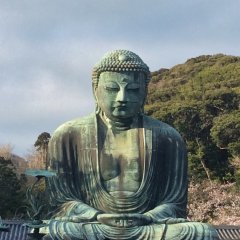Overview
Kaskukabe City for most visitors to Japan is merely a place to change trains at a major hub that takes you to Omiya City for the Railway Museum and the Bonsai Village. At Kasukabe Station there are quick connections for a soak in the onsens of Kinugawa or further on to the historic sights of Aizu Wakamatsu and Nikko. But take some time in Kasukabe City to see some natural and historical beauty and some monumentally large things, including a famous posterior.
Temples and Shrines

Kasukabe City's Hachiman Shrine is a tribute to the original in Kamakura City. At Kasukabe’s replica, you’ll find two magnificent ginkgo trees that glow with intense golden color in November. These two trees were cultivated from cuttings of the two great ginkgo trees of the Kamakura shrine. On the west side of Kasukabe Hachiman Shrine, follow the path to a miniature pilgrimage up a hillside with small shrines dedicated to Katori, Atago, Kashima Shrines, and Mt. Koya’s Okunoin. It’s a tiny pilgrim path that is a courtesy to those who are too infirm to make the more arduous trips to these spiritual destinations.
Kasukabe Tsurugaoka Hachiman Shrine is a three-minute walk from Yagisaki Station on the Tobu Urban Park Line.

Saishoin, a Shingon Buddhist temple just north of Kasukabe Station was once the terminus for the original rail line that ran from Tokyo to the old Nikko post town of Kasukabe Juku. It’s quiet any time of year, but in late March and early April, it’s a lovely, uncrowded spot to take in cherry blossoms. Testament to the gnarled cherry trees in the garden is the large cherry emblem on the gate.
Saishoin is a 10-minute walk from Kasukabe Station.
Gardens and Parks
In late April and early May, a deconsecrated temple in Kasukabe opens its gate for a spectacular display of wisteria at Tokaen. Said to be over 1200 years old and planted by the Buddhist saint Kobo Daishi, the vines still produce long trailing and lightly fragrant blossoms.
Tokaen is a 10-minute walk from Fuji no Ushijima Station on the Tobu Urban Park Line.
Near the Edo River, Showa General Park is a mere 15 hectares of space, but it is a great spot to appreciate waterfowl at Shukei Pond surrounded by mature trees. The park has barbecue facilities and a children’s center with a library. Showa General Park is a 20-minute walk from Minami-Sakurai Station on the Tobu Urban Park Line.
Festivals
On May 3rd and 5th every year in celebration of children, Kasukabe residents hoist giant kites weighing up to 800 kilograms into the sky on the Edo Riverbank. The kites that require crews of up to 100 people to haul are emblazoned with encouraging messages. The Kasukabe Giant Kite Festival will be held without spectators in 2022, but it is hoped the food and festivities return next year.
In late December, craftspeople sell their highly decorated hagoita, or battledore rackets. Pick up a souvenir maiden or hero or a number of other traditional craft items at the Kasukabe Hagoita Market near Kasukabe Station.
Places of Interest

Kasukabe City is home to the largest floodwater diversion system in the world. The Metropolitan Area Outer Underground Discharge Channel, a mouthful abbreviated to G-CANS, is a series of 65-meter deep concrete cisterns and a 6.4-kilometer-long tunnel to siphon off typhoon rains. The space, popularly called The Underground Temple for its vast space and towering support columns, is open to vsitors.
I did mention a bottom, so at the tail end of this guide, I recommend to you Kasukabe City's most famous fictional resident, Crayon Shinchan. This mischievous boy is known to moon alien invaders. The city pays homage to this cheeky franchise as it was the residence of the creator Utsui Yoshito. On your visit to Kasukabe City, you may spy characters from the Crayon Shinchan animation series on train platforms, bus livery, and signboards. At the theme park studio in Kasukabe Lala Garden shopping center play Crayon Shinchan games to your heart’s content.


































I always remember the parent trees, one which was lost in a typhoon a few years ago. Glad these descendants live on.